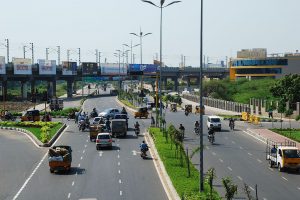Nagraj Adve
Hurricane Irma draws our attention yet again to something that bears repetition: that those most affected by global warming’s impacts are the people least responsible for them. This is Vivian Richards country, with the cricket stadium named after its most illustrious son. Where Andy Roberts and Curtly Ambrose once caused havoc among visiting test batsmen. It’s now witnessing havoc of a different kind. Antigua and Barbuda, the Caribbean nation where these great players came of age, has just been flattened by Hurricane Irma, the island of Barbuda facing its brunt. Its prime minister has said that 90% of the island’s buildings have been destroyed and over half its small population rendered homeless.
Hurricane Irma is one of the strongest-ever hurricanes in the Atlantic. Its wind speed, 290 km per hour at its peak, was until recently at least 40 kilometres an hour above the threshold of a Category 5 hurricane, the highest in the 1-5 scale by which hurricanes are graded, basically for their capacity to cause destruction. A hurricane with sustained winds of between 118 to 152 km an hour is designated Category 1, and each category signifies wind speeds roughly 30 km an hour stronger. Irma was so way off the charts that some people were (erroneously) saying it should be called a Category 6 hurricane.
This hurricane has, over the last couple of days, powered its way through the Caribbean sea, killing at least 21 people, and decimated homes, schools, hospitals and other infrastructure in parts of St Martin, the Virgin Islands, Anguilla, the Turks and Caicos islands and Puerto Rico. It is currently over Cuba, and will shortly hit the eastern coast of the US with winds of around 248 km an hour. It’s also massive, with hurricane winds over a 100 kilometres from the storm’s centre. Storm surges of over 12 feet are expected to pummel the coast for hundreds of kilometres along Florida, Georgia and North Carolina. Over 5 million people have been told to leave their homes for greater safety in Florida alone. The people in areas it is going to hit have no lived experience of anything so massive.
The Fingerprints of Global Warming
Experts have voiced their surprise that Hurricane Irma has surfaced so soon after Hurricane Harvey. In fact, Irma is being accompanied by Hurricanes Jose to its east and Katia to its west. Jose, itself close to Category 5, will be the second to hit the Caribbean islands in just a couple of days. It’s made some raise what is increasingly becoming an obvious question: to what extent does global warming have a role to play? To which I would add one voiced less frequently: why should those least responsible for global warming have to constantly face its effects? And what does it bode for the future?
Ocean water temperatures need to cross 26.5º C to depths of 50 metres for tropical cyclones to form. (It’s a necessary condition but not a sufficient one. Other favourable conditions are needed, for instance the absence of winds at a higher level that can interfere with hurricane formation.) Over 60% of the extraordinary amount of heat energy trapped by greenhouse gases since 1971 – about 170,000 billion billion joules – has gone into the upper oceans, according to the IPCC’s Fifth Assessment Report. It’s a number so bewilderingly large that an easier way of conceptualising it is this: averaged out each year, it equals 40-times the entire annual energy consumption of the US. The consequently warmer upper ocean waters ensure that, when other conditions are right, there’s a greater chance of hurricanes forming and sustaining themselves for a longer duration. Or getting more intense. Or them forming one after the other, as has happened with Irma and Jose.
Another way global warming is implicated has to do with storm surges now pummelling Cuba, followed by the US over the weekend. Swirling hurricane winds pull in massive volumes of sea water. Out in the open sea, those waters are forced downwards into the ocean depths. But once the hurricane approaches land, the shallower seabed means the excess water pulled in by the hurricane has nowhere to go, so it just piles up and overwhelms the shore. What’s more, the concave shape in this part of the US eastern coast “will funnel and concentrate the storm surge to ridiculous heights”,Jeff Masters, a world-renowned authority on hurricanes, warned three days ago.
Of relevance here is that sea levels are on average about 20 cm higher than they were a century ago, and about half a foot higher than a few decades ago. But that’s only a global average. The sea level rise off the US eastern coast is more than this average, at least a foot higher. So when storm surges occur in this region, they are a foot higher than they used to be, without global warming. “People think that 10 to 30 centimetres is not much, but a relatively small average rise in sea level is manifested in extreme high tide and storm surge events,” the climate scientist Gerald Meehl wrote in the journal Nature in 2005. In passing, this applies to storm surges off India’s coasts as well, including events that have nothing to do with climate change, such as the tsunami of December 26, 2004. When the tsunami hit, the waters off Tamil Nadu’s and other coastlines came in higher and stronger because of sea level rise.
Who Bears the Brunt?
The carbon footprint of the people in the Caribbean is largely quite modest. According to the latest available US EIA data, Jamaica and other Caribbean nations hover around 2.5 tonnes of carbon dioxide per person, and each person in Haiti emitted a mere 0.25 tonnes – compared to the US at 16 tonnes of carbon dioxide per capita. And national per capita emission averages always hide inequalities of income and wealth. The poor everywhere emit much less than the average. Caribbean economies depend a lot on tourism and agriculture, also their main sources of employment. Both sectors have been devastated by Hurricane Irma, and a majority of people would have lost their immediate work and sources of livelihood.
But for now, uppermost on their minds is the damage to homes and infrastructure that support daily life. The mayor of the capital of Puerto Rico said that “power infrastructure is very fragile and we expect to be without power for the next four to six months”. In a video hosted on the New York Times, islanders from the small Caribbean island of St Martin narrate Irma’s devastation: “The island is completely destroyed. People are crying on the streets. They don’t have nowhere to go. There are places where there were houses. Now there is nothing. Not even a piece of wood, nothing. … I don’t know how many years it will be before St Martin recovers from such a catastrophe.” Hurricane Irma draws our attention, yet again, to something that bears repetition: that those most affected by global warming’s impacts are the people least responsible for them. As Hurricane Katrina did: it was the African-Americans in the poorest neighbour-hoods of New Orleans that bore its brunt the most.
The only country that has – thus far – borne these hurricane assaults relatively well is Cuba. Authorities elsewhere, whether in the United States, or here in India, would do well to borrow from practices there. Having being buffeted by regular hurricanes, Cuba is now constantly, through the year, prepared for the next one. Since 1986, every single Cuban has participated each year in a two-day hurricane exercise. Hurricane preparedness is part of school curricula. Citizens are engaged in this process at all levels, each person knows where to go and there is an extraordinary level of cooperation. Particular attention is paid to the economically and physically vulnerable, and its remarkable healthcare system ensures that everyone has access to hospitals both during and after a hurricane. Not surprisingly, despite facing the brunt of Hurricane Katrina in August 2005, no one died in Cuba while 1,800 people were killed in the US, a vastly wealthier country. Having said that, Hurricane Irma is outside most people’s lived experience, so the extent of deaths and damage it may cause even in Cuba may be considerable and will only become clear over the next several days.
What of the Future?
What do recent trends tell us about the future? “It is virtually certain,” says the IPCC’s Fifth Assessment Report, “that there has been an increase in the frequency and intensity of the strongest tropical cyclones in the North Atlantic since the 1970s.” Elsewhere, it says that “increases in the intensity of the strongest storms in the Atlantic appear robust” (WG1, chapter 2, p 217). Warmer oceans have meant that hurricanes are already forming in areas of the world’s oceans where they never did before. As hurricanes draw their energy from ocean heat, they will likely get stronger. Only the most thorough readiness, and wisdom, will prepare us for hurricanes of the future. At least, one hopes. With wisdom, we seem to be in reverse gear. Elites seek to build foolishly on coastlines, whether here in India or in the US – coal power plants, oil rigs, tourism facilities or homes for the well-off. And destroy mangroves to make way for these symptoms of the “forever growth” malaise. We seem hell-bent on making ourselves more vulnerable. We need to not just challenge and reverse this foolhardy development trajectory but also interrogate the underlying thought process and the economic logic of maximising profit that make it happen.


















